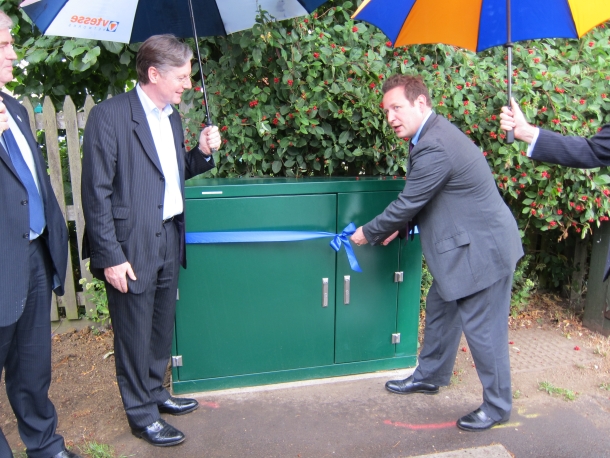Ofcom: Level playing field needed for rural broadband

Publicly-funded super-fast broadband networks in rural parts of the UK must allow open access to a variety of internet providers, Ofcom has said.

Communications minister cuts the ribbon on a new fibre cabinet in Birch Green village in August 2010. Photo credit: David Meyer
Ed Richards, the regulator's chief executive, said on Tuesday that single operators should not be able to dominate rural networks, as this would hurt competition and innovation. He also said a long-term solution to more effective fibre network competition might lie in a technology called wavelength unbundling, which would let different operators share a fibre cable by using different light wavelengths.
"We believe that open access must be provided as part of any publicly financed initiative, together with interoperable standard systems which maximise the potential for effective downstream competition," Richards said in a speech at Total Telecom World conference. "The danger otherwise is that we end up with single vertically integrated providers in a range of areas and an absence of choice, innovation and competition."
Richards added that letting one operator hog the rural broadband line would be "a particularly egregious outcome if delivered by virtue of taxpayers' money rather than private risk capital".
The government is in the process of distributing £530m to operators for building super-fast broadband networks in rural areas, which the operators would otherwise see as poor investments due to their low population density.
BT is the main company rolling out fibre to the majority of the UK, with a focus on densely-populated areas. The firm says it will offer fibre-based broadband access to two-thirds of the population by the end of 2014, drawing on its own coffers, but chief executive Ian Livingston noted last week that the government's additional funding should lead to 90 percent coverage by around 2017.
Virgin Media decried the situation in September, claiming BT would probably end up as the sole provider of fibre-based connectivity in most of the countryside.
In the era of copper, the UK regulator's way of ensuring real competition was to force BT to allow local-loop unbundling (LLU) — in other words, to let other operators physically install their kit in BT's telephone exchanges, taking BT and its wholesale products almost entirely out of the equation.
The European Commission wants the same to happen with BT's fibre network. However, Ofcom is keen on a different system known as virtual line unbundled access (VULA). The Commission has approved VULA as a way of ensuring BT's rivals get a better chance at being competitive, but only as a temporary measure.
Wavelength unbundling
A possible long-term solution to the problem might be a technology called wavelength unbundling, or, more properly, wavelength-division multiplexing (WDM). Whereas a current fibre network uses one pulse of light, this advance would let competing providers offer different services using the same single cable, by each running their services on different wavelengths.
Apart from potentially increasing capacity by four times, this would make it a lot easier to ensure competition among the suppliers.
The idea of WDM has been around for decades — it is needed to run bidirectional signals over a single fibre strand, for one thing — but it is still being developed. Ofcom is working with telecoms bodies such as the International Telecoms Union (ITU) to help finalise the standards.
"Wavelength division multiplexing is already used in the core network but as the economics improve, and with the right equipment at the head-end and in customers' premises, it is expected to move into the access network also," Richards said. "With these elements in place, the potential may exist for a competition remedy — unbundling at the wavelength level — in which different communications providers address individual customers each using a different wavelength."
However, Richards noted that WDM was unlikely to be a possibility for end-user access before 2015 at the earliest.
For now, Richards said, Ofcom is focusing on VULA for the 'two-thirds' commercial fibre rollout, and on regulation of duct-and-pole access prices for the government-subsidised rural deployments that will make up 90 percent overall coverage.
However, this leaves the final 10 percent, which will probably require a mix of local, regional, national and European funding, and will almost certainly need a combination of wired and wireless technology. Given that VULA only works on wired fibre networks, and that wireless connectivity has nothing to do with BT's ducts and telephone poles, Richards indicated that he was particularly concerned about competition in these cases.
"We have worked with the government to identify some key criteria to ensure that public investment is the friend of competition and not inadvertently its enemy," Richards said. "While I have emphasised the challenges of investment and of new technologies, we should be clear that there is no future in which we will not support vibrant and effective competition."
The Ofcom chief also addressed the crucial issue of people actually choosing to use super-fast broadband. He noted that subscriber numbers were "still low" and theorised that this was because there is no "killer app" that demands such fast speeds, apart from several members of a household using the internet at once.
"Amid a cornucopia of entertainment and information services, and the promise of advanced telemetry, e-health and interactive education, it is interesting that the only 'killer app' we have so far is the presence of teenage children," Richards said.
"So there remains uncertainty within the sector about the level of demand for superfast services and of course willingness to pay. Yet it is clear that consumption of data continues to surge."